Loss of Glycosaminoglycan Receptor Binding after Mosquito Cell Passage Reduces Chikungunya Virus Infectivity
- PMID: 26484530
- PMCID: PMC4615622
- DOI: 10.1371/journal.pntd.0004139
Loss of Glycosaminoglycan Receptor Binding after Mosquito Cell Passage Reduces Chikungunya Virus Infectivity
Abstract
Chikungunya virus (CHIKV) is a mosquito-transmitted alphavirus that can cause fever and chronic arthritis in humans. CHIKV that is generated in mosquito or mammalian cells differs in glycosylation patterns of viral proteins, which may affect its replication and virulence. Herein, we compare replication, pathogenicity, and receptor binding of CHIKV generated in Vero cells (mammal) or C6/36 cells (mosquito) through a single passage. We demonstrate that mosquito cell-derived CHIKV (CHIKV mos) has slower replication than mammalian cell-derived CHIKV (CHIKV vero), when tested in both human and murine cell lines. Consistent with this, CHIKV mos infection in both cell lines produce less cytopathic effects and reduced antiviral responses. In addition, infection in mice show that CHIKV mos produces a lower level of viremia and less severe footpad swelling when compared with CHIKV vero. Interestingly, CHIKV mos has impaired ability to bind to glycosaminoglycan (GAG) receptors on mammalian cells. However, sequencing analysis shows that this impairment is not due to a mutation in the CHIKV E2 gene, which encodes for the viral receptor binding protein. Moreover, CHIKV mos progenies can regain GAG receptor binding capability and can replicate similarly to CHIKV vero after a single passage in mammalian cells. Furthermore, CHIKV vero and CHIKV mos no longer differ in replication when N-glycosylation of viral proteins was inhibited by growing these viruses in the presence of tunicamycin. Collectively, these results suggest that N-glycosylation of viral proteins within mosquito cells can result in loss of GAG receptor binding capability of CHIKV and reduction of its infectivity in mammalian cells.
Conflict of interest statement
The authors have declared that no competing interests exist.
Figures
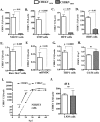
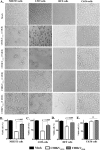
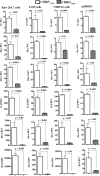
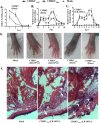

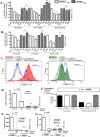
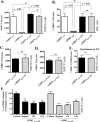

Similar articles
-
Residue 82 of the Chikungunya virus E2 attachment protein modulates viral dissemination and arthritis in mice.J Virol. 2014 Nov;88(21):12180-92. doi: 10.1128/JVI.01672-14. Epub 2014 Aug 20. J Virol. 2014. PMID: 25142598 Free PMC article.
-
Disruption of the Opal Stop Codon Attenuates Chikungunya Virus-Induced Arthritis and Pathology.mBio. 2017 Nov 14;8(6):e01456-17. doi: 10.1128/mBio.01456-17. mBio. 2017. PMID: 29138302 Free PMC article.
-
Chikungunya virus induces a more moderate cytopathic effect in mosquito cells than in mammalian cells.Intervirology. 2013;56(1):6-12. doi: 10.1159/000339985. Epub 2012 Aug 16. Intervirology. 2013. PMID: 22907160
-
Early Events in Chikungunya Virus Infection-From Virus Cell Binding to Membrane Fusion.Viruses. 2015 Jul 7;7(7):3647-74. doi: 10.3390/v7072792. Viruses. 2015. PMID: 26198242 Free PMC article. Review.
-
Cellular Attachment and Entry Factors for Chikungunya Virus.Viruses. 2019 Nov 19;11(11):1078. doi: 10.3390/v11111078. Viruses. 2019. PMID: 31752346 Free PMC article. Review.
Cited by
-
Sulfated Glycans and Related Digestive Enzymes in the Zika Virus Infectivity: Potential Mechanisms of Virus-Host Interaction and Perspectives in Drug Discovery.Interdiscip Perspect Infect Dis. 2017;2017:4894598. doi: 10.1155/2017/4894598. Epub 2017 Jan 19. Interdiscip Perspect Infect Dis. 2017. PMID: 28203251 Free PMC article. Review.
-
Glycosaminoglycan binding by arboviruses: a cautionary tale.J Gen Virol. 2022 Feb;103(2):001726. doi: 10.1099/jgv.0.001726. J Gen Virol. 2022. PMID: 35191823 Free PMC article. Review.
-
Glycosaminoglycan Compositional Analysis of Relevant Tissues in Zika Virus Pathogenesis and in Vitro Evaluation of Heparin as an Antiviral against Zika Virus Infection.Biochemistry. 2019 Feb 26;58(8):1155-1166. doi: 10.1021/acs.biochem.8b01267. Epub 2019 Feb 13. Biochemistry. 2019. PMID: 30698412 Free PMC article.
-
Recombinant protein expression in Acanthamoeba castellanii.Front Bioeng Biotechnol. 2025 Mar 20;13:1524405. doi: 10.3389/fbioe.2025.1524405. eCollection 2025. Front Bioeng Biotechnol. 2025. PMID: 40182995 Free PMC article.
-
Anti-Obesity Effect of Bombus ignitus Queen Glycosaminoglycans in Rats on a High-Fat Diet.Int J Mol Sci. 2017 Mar 22;18(3):681. doi: 10.3390/ijms18030681. Int J Mol Sci. 2017. PMID: 28327528 Free PMC article.
References
-
- Gauri LA, Ranwa BL, Nagar K, Vyas A, Fatima Q (2012) Post chikungunya brain stem encephalitis. J Assoc Physicians India 60: 68–70. - PubMed
-
- Pellot AS, Alessandri JL, Robin S, Samperiz S, Attali T, et al. (2012) [Severe forms of chikungunya virus infection in a pediatric intensive care unit on Reunion Island]. Med Trop (Mars) 72 Spec No: 88–93. - PubMed
Publication types
MeSH terms
Substances
Grants and funding
LinkOut - more resources
Full Text Sources
Other Literature Sources
Medical

